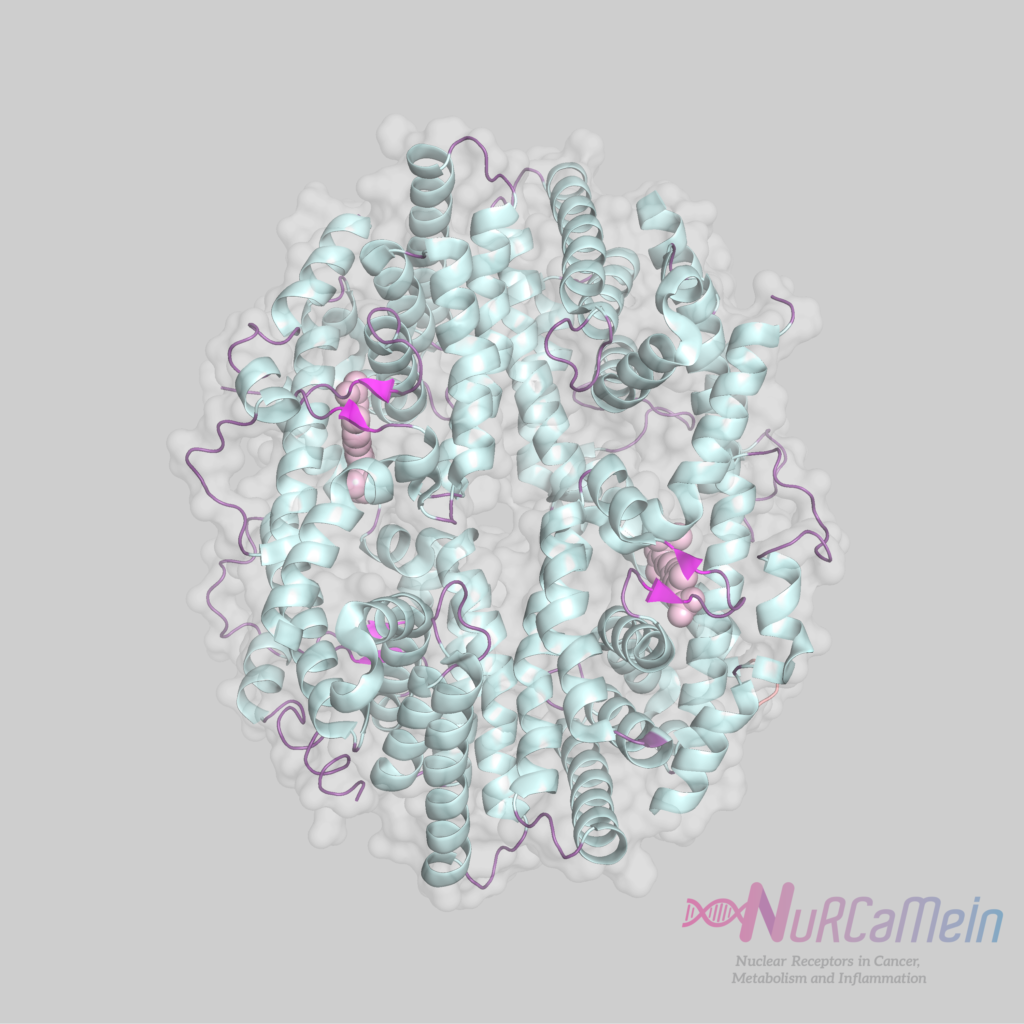RXR (RETINOID X RECEPTOR)
X retinoid receptors (RXRs) are nuclear receptors that function as homodimers or heterodimers with other nuclear receptors, playing an important role in cell proliferation and cell death, development, metabolism, and cell differentiation.
Ligands
Among ligands capable of activating RXRs there are unsaturated fatty acids (such as docosahexaenoic acid) and derivatives of vitamin A (specifically, 9-cis retinoic acid). However, the low endogenous levels of these molecules in certain tissues has motivated the search for alternative natural ligands. Recently, 9-cis-13,14-dihydroretinoic acid or C24: 5 long chain fatty acid have been proposed as new endogenous regulators of RXR.
It is worth noting the rexinoids or the RXR synthetic ligands, as well. Among them is bexarotene, used as a drug in different types of cancer.
Classification
RXRs are members of the NR2 subfamily, which in turn is part of the large nuclear receptor superfamily.
Based on their affinity for the ligand and its mode of action, RXRs are classified as “adopted” and Type II receptors.
Structure and interactions
All members of the nuclear receptor family share a general multi-domain structure. RXRs are made up of the following domains:
- A/B domain (NTD N terminal domain / AF-1): coactivators binding region in the N-terminal position, with DNA transactivation function (AF-1), being able to operate dependently or independently of the ligand.
- C domain (DBD, DNA binding domain): Highly conserved DNA binding region, containing two “zinc fingers” that interact with specific hormonal response elements (HREs motifs), and mediating receptor dimerization .
- D domain or “hinge region”: region that unites domains C and E, and which gives flexibility to the receptor.
- E / F domain (LBD / AF-2): region of ligand binding and interaction with coactivators and corepressors (ligand-dependent AF-2 transactivation function), in C-terminal position.

RXR structure | Presumably an autorepressed not transcriptionaly competent RXR form.
RXRs form heterodimers with receptors of the NR1 subfamily (such as TR, LXR, PPAR, VDR or RAR), in a “permissive” and “non-permissive” way. Permissive heterodimers are those that can be activated by an RXR agonist ligand on its own or by the ligands of the other receptor that forms the complex (heterodimers with PPAR or LXR, for example). The non-permissive are those heterodimers that can only be activated by the ligand of the receptor with which RXR forms the dimer (VDR, TR or RAR for example).
As with other Type II nuclear receptors, in the absence of ligand the RXR heterodimer is linked to the DNA HREs motifs, which in turn are associated with corepressor proteins that repress gene expression.
The binding of an agonist ligand to the receptor induces a conformational change in the LBD domain, resulting in the dissociation of corepressors and the recruitment of coregulator complexes that activate the promoter and the transcription of the target genes.
Expression
There are three types of RXR (RXRα or NR2B1, RXRβ or NR2B2 and RXRγ or NR2B3) that, in turn, have two isoforms with partially redundant functions. Despite the fact that RXRs are expressed in almost all body tissues, the expression of each of the isotypes depends on the cell type:
- RXRα1/α2: present in the liver, lung, muscle, kidney, intestine epidermis and myeloid cells.
- RXRβ1/β2: they are distributed ubiquitously.
- RXRγ1/γ2: both variants are the main isoforms of muscle tissue (skeletal and cardiac). Furthermore, RXRγ1 has been identified in the brain.
Main functions
RXRs play a critical role due to their ability to associate with other nuclear receptors and the expression of one or more of the three isoforms (RXRα, β and γ) in each cell type of the organism. Their functions are key, above all, in the control of development processes and homeostasis. Since they are lipid sensors, they play an important role in the communication between metabolism and the immune response. Given this function, they could be an interesting therapeutic target for the treatment of diseases of immunological and metabolic origin.
RXRs in the NuRCaMeIn Network
- Nuclear Receptor Signaling Laboratory | Centro Nacional de Investigaciones Cardiovasculares de Madrid.
- RXRs in Metabolic and Cardiovascular Diseases | Nurcamein
References
- Retinoid X Receptor Antagonists, Masaki Watanabe et al. | International Journal of Molecular Sciences
- Retinoid X Receptor Selective Agonists and their Synthetic Methods, Carl E. Wagner et al. | Current Topics in Medicinal Chemistry
